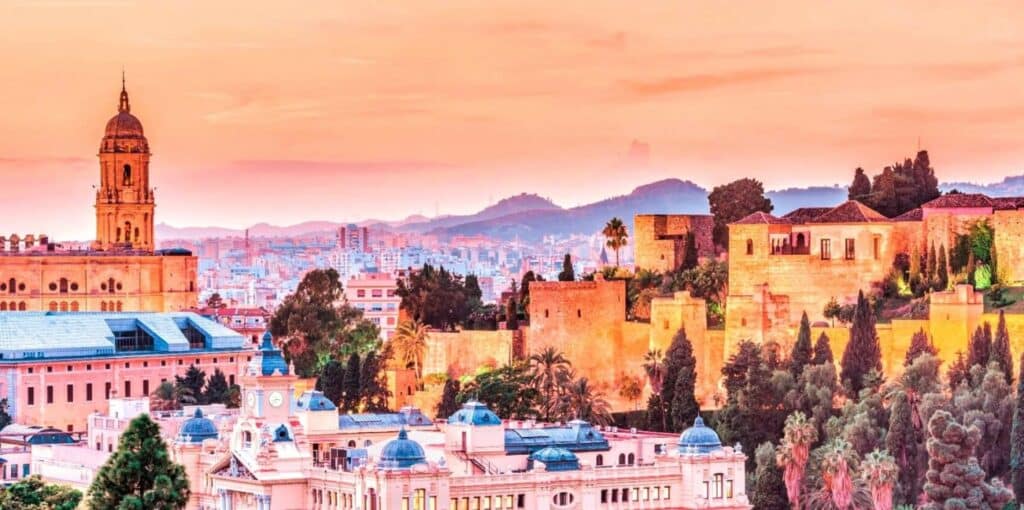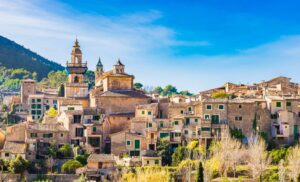Want to really get to know Malaga? Walk through these 7 streets of Malaga and the city will no longer have any secrets for you!
Malaga is a city of streets with a Jewish and Arabic layout, roads with their own names and sights. You can wander around for hours in history and heritage and there are countless special sights waiting to be discovered by you.
Calle Larios
In 1891, the famous Marqués de Larios street, the most famous street in Malaga, was inaugurated, an ‘artery’ through which the Mediterranean breeze blows. The street owes its name to Manuel Domingo Larios y Larios, Marquis II of Larios, whose statue, the work of Mariano Benlliure, marks its beginning.
History books claim that Larios could well be the most elegant street of the 19th century. Why? Because the architect Eduardo Strachan designed it, flanked by buildings with a curved design on the corners, inspired by the Chicago school. In this way it balanced this emblematic street and made it symmetrical, thereby somehow revolutionizing the image of the city. Furthermore, as a curiosity, Strachan drew an imaginary vanishing point where all the lines of cornices and balconies meet.
Nowadays Calle Larios is the beating heart of the center when it comes to events. Christmas, Carnival, Easter, the Feria in August and Fashion Week all find their stage in this street. We also find countless shops, some with a lot of history, Calle Larios is an indispensable stop when visiting the city. We think this is one of the most beautiful streets in Malaga.
Avenida Manuel Agustín Heredia
This avenue is also known as “Muelle Heredia” and forms a barrier between the center and the port of Malaga. It is located on land reclaimed from the sea and was created at the same time as the Paseo del Parque. The name is taken from a businessman and industrialist from Malaga, one of the promoters of the city’s industrialization in the 19th century, whose sculpture is located on the same avenue, near the Alameda de Colón.
This wide road was the location of the Malaga Feria at the beginning of the last century. Here you can now see unique buildings that overlook the Mediterranean Sea. For example, office blocks, the Palace of Justice, the trade union headquarters and the Health Center (now the Alameda-Perchel health center) were built on the northern flank. Port service buildings were built on the harbor edge, such as customs, the civil guard, the fishermen’s guild (Aula del Mar) and some warehouses.
Calle Alcazabilla, where heritage lives
From the Customs Palace in Cortina del Muelle to Victoria Street, there is undoubtedly the most historic street in the city: Calle Alcazabilla. The name, which is derived from the Alcazaba of Malaga, located on this road, comes from the Arabic al-Qasabiya, meaning “street of the Alcazaba”.
But in addition to the Muslim fortress, in this street we also find the city’s Roman theater, which dates from the 1st century BC and is freely accessible.
The Customs Palace, today the headquarters of the Museum of Malaga, is an architectural jewel, a place where thousands of architectural pieces and works of art from different periods can be found.
The Gardens of Ibn Gabirol (now Manuel Atencia Garcia), behind which lies the Picasso Museum; the glass pyramid that shelters the Roman garum pools; or the Cine Albéniz, are other sites you can visit in this special street.
From the Plaza de la Constitución to the Plaza de la Merced: Calle Granada
The old madina of Malaga is the protagonist of the next story, that of Calle Granada, a central street that connects the Plaza de la Constitución with the Plaza de la Merced.
Winding, narrow and elongated, like the Arab streets, this emblematic road gives access to Málaga’s Jewish Quarter, Calle San Agustín – where the Picasso Museum is located – or Calle Beatas. We also find here the Church of Santiago, the oldest in the city, and where the painter Pablo Picasso was baptized in 1881.
It is one of the liveliest streets in Malaga, always full of curious visitors who come to visit the shops, many of which are artisanal, or to sample the best of Malaga’s gastronomy on one of the terraces.
Calle Victoria, the main street of a traditional neighborhood
The patron saint of Malaga, Santa María de la Victoria, gives her name to the main artery of the district of the same name. This street spans the 650 meters that separate Plaza de la Merced from Plaza de la Victoria, a route that the troops of the Catholic Monarchs followed when entering the city and setting up camp.
Along this road we find the Plaza de la Victoria, formerly known as the Monkey Garden, the Church of San Lázaro and the famous Marist School of Málaga.
Calle Compañía, Thyssen area
Calle Compañía, which joins the west and east of central Malaga and is only 220 meters long, connects Plaza de la Constitución with Puerta Nueva. With a narrow layout, as marked by Muslim canons, it was named Calle de las Guardias after the arrival of the Catholic Monarchs in the city. Here houses were distributed to the squires and guards of the royal armies.
The Jesuits settled on this site with the creation of the Novitiate of San Sebastián (a school that today is the headquarters of the Ateneo de Málaga and the University of Orfeón) and the Church of Santo Cristo de la Salud (built on the remains of the Hermitage of San Sebastián, built on an old mosque) and the street’s name was changed in honor of the Jesuits. The road widens when it crosses Calle Salvago and Callejón de los Mártires, this is also the site of the Villalón Palace, which, together with other buildings, forms the current Carmen Thyssen Málaga Museum.
Calle Císter, history and art in the center of Malaga
From Plaza de la Aduana to the intersection with Santa María and San Agustín streets is Calle Císter, a street named after the Cistercian nuns of the Abbey of Santa Ana de Recoletas Bernardas del Císter, who gathered here in 1617.
Some historians say that the origins of this street could be on Via Decumana Máxima in Roman Malaga, although the Phoenician sanctuary of Malaga is documented in the area.
The Cathedral of Santa María de la Encarnación, the Palacio Zea-Salvatierra, the workshop of Pedro de Mena – today the headquarters of the Félix Revello de Toro Museum – and the aforementioned abbey are the most interesting monuments that we find in the area around Calle Císter.
Would you like to stay in this beautiful city yourself? Click here!



